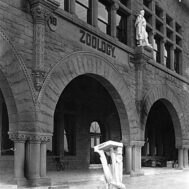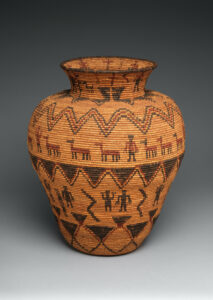
Storage basket, ca. 1890, Arizona or New Mexico, USA, Apache, The Charles and Valerie Diker Collection of Native American Art, Gift of Charles and Valerie Diker, 2019. A storage basket for family use. When the railroad brought tourists to the Southwest in the 1880s, weavers began producing baskets for this new market.
Legislation that could lock Native American art within U.S. borders is pending again before the U.S. Congress. Previous versions of the STOP Act in 2016, 2018 and 2020 failed to generate sufficient enthusiasm for passage. This was in part because of their perceived threat to the tourist-dependent economy in the Southwest, in part because the bills called for a built-from-scratch export regime that many privately acknowledged was unworkable – and due to concerns that they would lead to claims against the private collections of Native American art held by hundreds of thousands of Americans – this being one of the most popular forms of American collecting.
On May 20, 2021, the U.S. Congress’ House Subcommittee for Indigenous Peoples of the United States held a legislative hearing on HR 2930, also known as the ‘STOP Act.’ This is the fourth Congress in which a STOP Act has been introduced. This latest version is virtually identical to a substitute bill, S. 2165, that was introduced on the Senate side in mid-2020 and was passed by the Senate, but not the House, at the end of 2020.
The bill’s supporters have dismissed its potential to harm local economies in the Southwest. They deny that there will be problems in imposing a system that requires submitting forms and photographs of objects and waiting for tribal review in order to obtain export permits – despite the rules applying to items of any age and down to $1 in value. Foreign tourists who come to venues like the 100 year old Santa Fe Indian Market have a disproportionately high economic impact – spending far more money per person than domestic tourists do on hotels and restaurants as well as on Native American art. To a lesser extent, foreign tourism dollars also impact Northwest Coast tribes and Native Hawaiian communities. What will be the effect of seizures of legal goods simply for not having the requisite permits?
One of the most concerning aspects is the potential for overreach by imposing a not-to-be-questioned tribal characterization of a broad array of Native American art and artifacts as ‘cultural patrimony’ on export. There are an increasing number of claims made by activists (including by groups that do not actually represent specific federal tribes such as the Association on American Indian Affairs) against U.S. museums holding Native American collections and auction houses that are selling ordinary Native American art – not sacred items. Claims about trading in ‘sacred items’ have been made recently against items including new kachina dolls, 1950s Alaskan tourist carvings, ordinary pipes and tools, and Hawaiian personal ornaments, to name just a few.
A closer look at the bill reveals that it lacks sufficient safeguards and that its plan to operate in secrecy – denying Freedom of Information Act access to the basis for refusal to allow export even to an exporter whose goods are seized – fails to allay these concerns.
All Parties Share the Goals of Protection of Sacred Items and Return of Stolen Objects
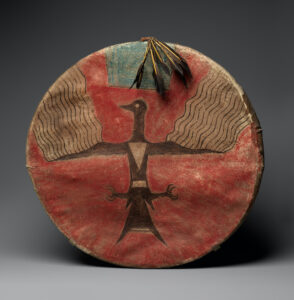
Shield, Artist: He Nupa Wanica/ Joseph No Two Horns (Hunkpapa Lakota/ Teton Sioux, 1852–1942), ca. 1885, Standing Rock Reservation, North Dakota, USA, Hunkpapa Lakota/ Teton Sioux. The Charles and Valerie Diker Collection of Native American Art, Gift of Charles and Valerie Diker, 2019.
Met description: The courageous warrior No Two Horns notably fought in the 1876 Battle of the Little Bighorn. Here, he portrays a bird with lightning or power emanating from its wings to protect the warrior. He also painted these powerful lines on his face and his horse’s body in self-portraits. Though he made later versions of this shield on muslin, this hide is a rare original.
Various bills bearing the name of the STOP Act have been introduced since 2016. Their primary purpose has been to prevent the export of items that have been illegally obtained through violations of U.S. laws protecting cultural heritage: the Native American Graves Protection and Repatriation Act (NAGPRA) and the Archaeological Resources Protection Act of 1979 (ARPA).
The goal of halting export of Native American objects that have been unlawfully taken from tribes or from federal and Indian lands has been strongly supported by the art trade, especially by the Authentic Tribal Art Dealers’ Association (ATADA). ATADA has gone even further by creating a highly successful Voluntary Returns Program to bring ceremonial items that were lawfully acquired back to tribes – not under legal compulsion, but because it is the right thing to do.
While fully supporting this primary goal, ATADA has objected to certain elements of the STOP Act. Some of its provisions pose a real danger to the legal private ownership of art and artifacts by hundreds of thousands of U.S. citizens, as well as to museums by the undercutting of NAGPRA. They threaten constitutional due process by imposing religiously-based rules of secrecy. This will harm the important tourist economy of the Southwest through a burdensome application process without time limits or exceptions for low value items, including the interests of Native American artisans dependent upon a vigorous tourist trade for sale of their art.
H.R. 2930 was introduced[1] by the subcommittee’s new chair, New Mexico Congresswoman Teresa Leger Fernandez.[2] There were two witnesses testifying on the legislation – Brian Vallo, Governor of the Pueblo of Acoma, and Bob Gallegos, Treasurer and former President of ATADA. Each presented testimony on the legislation and the issues it raises for the Native American community and the public, respectively.
Unfortunately, the hearing provided only an incomplete understanding of the legislation and a number of serious issues with the current draft bill went unaddressed in the public hearing.
Testimony of Acoma Pueblo Governor Brian Vallo
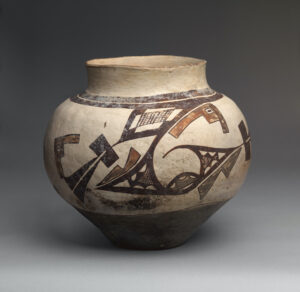
Acomita polychrome water jar, ca. 1790, Made in New Mexico, USA, Acoma, Native American. The Charles and Valerie Diker Collection of Native American Art, Gift of Charles and Valerie Diker, 2018.
The written testimony submitted by Governor Vallo asked the Subcommittee not to think of cultural heritage items in property rights terms, like title and ownership but to instead move beyond the Western view of property rights and consider the STOP Act as advancing human and cultural rights. He stated that past auction catalogs show how much tribal cultural heritage has left the country, citing to news articles written between 2013 and 2015.
Governor Vallo described the lengthy and difficult process of recovering a shield stolen from an Acoma home. After forty years (the theft never having been reported) it was offered for sale in Paris. He said that Acoma Pueblo was now actively monitoring auction sales but that he feared that, “our increased monitoring is driving the market underground, increasing black market activity hidden from the public eye.” (In fact, most auction houses have altered their policies and are no longer willing to sell such culturally sensitive items.)
Vallo stated that under U.S. law, not all items are “protected.” He stressed that there are statutory standards under which an item “must meet a threshold level of cultural significance and must have been taken from specific lands within specific time frames.” He asserted that current U.S. law does not facilitate the return even of items of great cultural significance. He did not explain how, if the STOP Act will only prevent export of items taken in violation of law, it would alter the provenance requirements of U.S. law, which he said were a barrier to repatriation.
Vallo noted that the bill has bipartisan support and that 25 tribal nations, tribal and regional associations and non-tribal organizations have provided letters of support for the bill.
He stated that “The STOP Act would allow the United States to use the existing international mechanism under which countries request the return of their cultural patrimony.” He did not state which international mechanism would effect this in his written testimony, but did claim in his oral remarks that the STOP Act would enable the U.S. to claim objects under the 1970 UNESCO Convention on the Means of Prohibiting and Preventing the Illicit Import, Export and Transfer of Ownership of Cultural Property.[3]
Governor Vallo’s written testimony is available here.
Testimony of Robert Gallegos, Treasurer and former President of ATADA
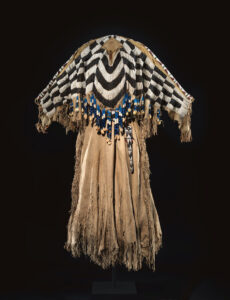
Dress and belt with awl case, ca. 1870, made in Oregon or Washington, USA, Wasco, The Charles and Valerie Diker Collection of Native American Art, Gift of Charles and Valerie Diker, 2019. Garments of superior craftsmanship incorporating trade goods, such as this example, expressed personal identity and a family’s high status.
Robert Gallegos first stated that ATADA is a staunch proponent of an ethical, culturally sensitive art industry. ATADA agreed with many of the goals of H.R. 2930 but not with others. ATADA appreciated the opportunity to assist in promoting legislation that protected tribal ceremonial and sacred items, strengthened enforcement of existing laws consistent with citizens constitutional rights and facilitated legitimate trade in legal items. However, he said, the 2021 Safeguard Tribal Objects of Patrimony Act, H.R. 2930, fails on all these counts.
Gallegos noted that ATADA long ago adopted Bylaws forbidding trade in items in current ceremonial use[4], established Due Diligence Guidelines to protect buyers and sellers[5], and set up public education programs working together with tribal representatives.[6] ATADA has built a highly successful, community-based Voluntary Returns Program to bring lawfully owned ceremonial objects back to tribes. Gallegos explained that ATADA’s community-based Voluntary Returns Program has expanded exponentially; so far, it has returned over 300 truly sacred items to tribes and another 30 important masks were being readied for return. Gallegos said that in his opinion, community-based returns were the most effective in building trust and furthering the goals of the STOP Act; he expressed concern that an overbroad bill would compromise these efforts.
In both his oral and written testimony, Gallegos identified a number of major concerns with the latest version of STOP – H.R. 2930:
- STOP places the entire burden of proof of “provenance” on the exporter, which given the unknown history of past ownership of the vast majority of items in trade (often for decades) is in effect a de-facto export ban.
- STOP lacks a “knowing” standard threatening law-abiding citizens with criminal prosecution.
- STOP creates a new export regime in the Department of Interior with all the uncertainties about what regulations will be imposed and delays inherent in starting an export system from scratch instead of using the existing AES Customs system.
- STOP places no time-limit on certification review serving as a bar to commercial transactions and scheduling of traveling exhibits.
- STOP provides for unchallenged Tribal right to review all certification applications; thereby giving Tribes unchecked authority to ban any and all exports without informing exporters why items have been forbidden or seized.
- STOP’s vague language does not state what happens to items claimed by Tribes on export.
- STOP blocks transparency by making all Tribal communications on certifications exempt from Freedom of Information Act requests and allows destruction of government records.
Gallegos asked, is the proposed legislation proportional to the problem? The first STOP Act was introduced after a series of controversial auction sales in Paris in 2016. Is there evidence of similar sales actually happening today or is this primarily a symbolic gesture that places a whole industry at risk with burdensome rules?
Gallegos’s testimony and answers to questions posed by the committee noted that some of these issues could be addressed through small modifications to the current language.
“For example. the legislation’s exclusion of commercial items in Section 5(b)(1)(B)(ii)(I)) is qualified by the phrase: item made solely for commercial purposes, which means that any items that may have a ceremonial purpose – ceramics, textiles, carvings, etc. would need to be certified as the specific characteristics that make them ceremonial are secret. The simple modification that would fix this provision would be to delete the word solely so it would read: item made for commercial purposes. The legislation also grants Tribes’ ability to halt export even of solely commercial items if Tribes challenge this presumption. ATADA urges the Committee to adopt this simple modification to ensure the legislation is consistent with the Chairwoman and Sponsor’s stated intent to exclude commercial items.”
Gallegos noted that the legislation lacks a “knowing” standard with bill language (5(a)(2)(1)) stating: and knows, or in the exercise of due care should have known.
He pointed out that given the secret nature of sacred items,
“a should have known standard will result in a need to certify all commercial items and expose exporters to criminal charges for failing to know what is secret. He suggested a simple modification that revises the language to read: and knows in the exercise of due care would fix this problematic provision.”
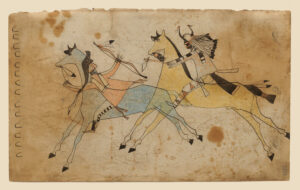
Swift Dog Strikes an Enemy, Swift Dog (Hunkpapa Lakota/ Teton Sioux, 1845–1925), ca. 1880, Made in Standing Rock Reservation, North Dakota, USA, Hunkpapa Lakota/ Teton Sioux, Native American, The Charles and Valerie Diker Collection of Native American Art, Gift of Charles and Valerie Diker, 2019
Met description: In the 1860s, Plains men began to render their personal histories and those of their people on sheets of paper and in ledger books that were captured from the military or obtained in trade. These works extended the earlier tradition of autobiographical warrior art incised on rock faces and painted on robes, shirts, and tipis. They became a way to document tribal life and history, affirming fundamental cultural values.
The lack of a time limit for the Secretary of the Interior to respond to applications or to issue or reject permission to export in Section 5(b)(4)(C)(I)) would be a barrier to legitimate business. The bill only states that regulations setting a “reasonable” time limit and “reasonable” costs would be determined later – but without any consultation whatsoever with the art industry.
Gallegos said that since H.R. 2930 does not exempt even newer, low value items or allow documented self-certification, the bill would not only harm non-Native American art dealers, but would threaten the all-important tourist trade in the Southwest and the incomes of Native American artisans and traders, many of whom rely on the Santa Fe Indian Market and other tourist venues for a large portion of their income.
In testimony on earlier versions of STOP, ATADA President Kim Martindale has noted that, “A self-certification process under U.S. law would never be a free ride as a false statement would lead to imprisonment, a significant safeguard. ATADA endorses self-certification to ensure a paper trail for exports and to provide true accountability.” However, H.R 2930 does not allow for documented and tracked self-certification.
The STOP Act requires tourists as well as commercial exporters to submit photos and forms and obtain permissions for exports as low as $1 value. These requirements will be impossible for most tourists to meet and will taint the domestic market with concerns that buying Indian art is ‘wrong.’ Too broad or too vague criteria would trap many foreign tourists, inevitably resulting in inadvertent, innocent violations and seizures for technical errors rather than criminal acts.
History of the STOP Act
Other versions of the STOP were introduced in 2016, in the 2017-2018 Congress, and in 2019-2020. Each bill has generated significant opposition. Each time the bills have grown longer – from 7 pages in 2016 to 38 pages in 2021. Each time, the bill’s provisions have become more far-reaching in their effect on the millions of Americans who have collected Native American art and on the art trade, including both antique dealers and contemporary Native artisans. Over time, provisions have been introduced that make the bill’s goals more obscure, its potential to undermine NAGPRA more likely, and its implementation more time consuming and burdensome. At the same time, the objects covered have become less defined and the secrecy surrounding them greater, the processes to legally export have become more ambiguous, and the future of the legitimate Native American art trade more uncertain.[7]
Since 2018, the various versions of STOP have been increasingly constitutionally suspect by failing to ensure a legitimate due process for persons accused of violations, by making the information on what objects are unlawful to export secret and by denying access to information on why an item is deemed unexportable even through Freedom of Information Act requests. As noted above, if it passes, the law is now far more likely to be violated inadvertently, trapping the unwary tourist who has no idea how to follow the export process, or forfeiting the property of the well-intentioned dealer who assumes that a commercial item is not covered, rather than actually catching criminals exporting stolen objects.
The First STOP Act S. 3127 / H.R.5854 – 2016

Hiilili Kokko (Katsina Figure), ca. 1900, Arizona, United States, Zuni, The Charles and Valerie Diker Collection of Native American Art, Gift of Charles and Valerie Diker, 2018. Met description: This Zuni Hiilili figure represents one of the hundreds of katsinam recognized by Pueblo peoples. The katsinam assume physical form during ceremonies to dance and present these figures to young girls, and the carvings hang in the girls’ homes afterward. In the late nineteenth century, makers began to produce katsina figures, also called kachina dolls, to sell to the outside market.
The first STOP Act introduced in 2016 doubled the penalty for violations of NAGPRA. It would have made it unlawful for a person to knowingly export a Native American cultural item or archaeological resource obtained in violation of either of two existing laws, the Native American Graves Protection and Repatriation Act (NAGPRA) and the Archaeological Resources Protection Act of 1979 (ARPA). There was no substantial objection to this provision, except that the legislation was unnecessary – Customs law already had a 10-year penalty for exporting an object contrary to law, and NAGPRA and ARPA already contain provisions against sale and transport and can serve as predicate statutes[8].
However, the 2016 STOP Act also directed that if persons voluntarily returned all Native American cultural objects in their possession to tribes, they would be immune from criminal prosecution under the Act. It implied that there was something inherently wrong or even illegal in possessing Native American ‘cultural objects’. There are hundreds of thousands of items that might be called ‘cultural objects’ that have lawfully entered private collections or have been in circulation in the US for decades. Why should a U.S. law direct that legally owned private property be repatriated?
Another key issue for collectors, dealers, and museums was that the bill failed to make clear the impossibility of knowing whether an object long in circulation is an unlawfully traded object under ARPA or one that is legal to own, sell, or trade. This is because if an object was taken from federal or Indian lands after passage of ARPA in 1979 it became illegal to possess or sell it; when it was collected from private land it was legal to do so. When objects have been circulating in the market for decades and their ownership history is unknown, there is no way to tell the difference between legal and illegal objects by any visual or physical characteristic. The problems were both the legal confusion and legal overreach this bill would create. The first STOP Act never made it through Senate or House committees for a vote.
The Second STOP Act S.1400 / H.R.3211 – 2017-2018
The 115th Congress (2017-2018) saw the introduction of a STOP Act that contained basically the same provisions as the first STOP Act but with a few more added. Most controversially, the new STOP Act stated that:
“It shall be the policy of the United States to encourage the voluntary return of tangible cultural heritage to Indian tribes and Native Hawaiian organizations by collectors, dealers, and other individuals and non-Federal organizations that hold such heritage.”
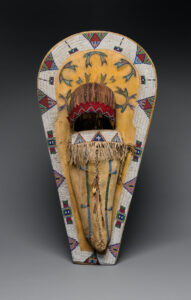
Cradleboard, ca. 1890, Colorado or Utah, United States; Ute, The Charles and Valerie Diker Collection of Native American Art, Gift of Charles and Valerie Diker, 2019. The yellow ocher color indicates that this was for a baby girl. The hood protected the child’s head and shaded its eyes.
This was a truly shocking proposition, that the U.S. government should have an official policy of returning all objects of Native American origin to tribes after more that 150 years of legal trade and collecting by individuals and institutions and in complete denial of long established protections of personal property.
(Native Americans have been making ceramics, carvings, jewelry, and weavings for commercial sale to other tribes, Spanish settlers and traders from many nations for hundreds of years. The first surge in popularity of Native American made items in the United States began in the 1880s and 1890s.[9] There are hundreds of thousands of Native American antique objects that have circulated in the market for decades, many of which are now said to have a ceremonial character or to be inalienable tribal ‘cultural heritage.’[10] In fact, the U.S. government was the primary motivator for the removal of tribal heritage as part of past military and political oppression, religious suppression that supplanted traditional religious practices with Christian ones, and forced acculturation into ‘White’ society.)
The bill also established various working groups and committees to advise the federal government made up of Indian tribes, academics, and government agencies, but did not include any input from the art trade. The second STOP act also failed in committee.
A Viable Alternative Bill Negotiated with the Pueblo of Acoma, H.R. 7075, Was Disregarded
During the same Congressional session, an alternative bill, H.R. 7075, the Native American and Native Hawaiian Cultural Heritage Protection Act of 2018 was introduced by Congressman Steve Pearce of New Mexico. The bill had very similar goals to the STOP Act, prohibiting the sale and exportation of tribal cultural items of American Indians, Alaska Natives, and Native Hawaiians that were obtained illegally and providing for the return of sacred objects, including through voluntary returns.
H.R. 7075 was the outcome of lengthy but productive negotiations between ATADA and representatives of the Pueblo of Acoma and was supported by both. However, it was not introduced until mid-October 2018 and did not make it through committee before the end of the Congressional session. Despite ATADA’s hope that H.R. 7075’s provisions would be used in the future as a guide for a successful compromise bill, after 2018, Acoma was no longer interested and a third version of STOP that could not be supported by collectors, museums, and the art trade was introduced instead in the following Congressional session.
The Third STOP Act – S. 2165 / H.R. 3846
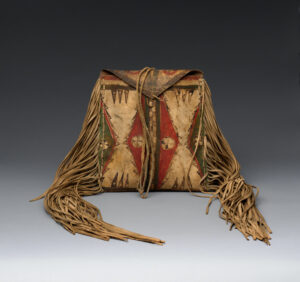
Parfleche flat case, ca. 1850, Texas or Oklahoma, USA, Comanche, The Charles and Valerie Diker Collection of Native American Art, Gift of Charles and Valerie Diker, 2019. Rawhide cases in cylinder, envelope, and box shapes called parfleche were used to transport important belongings from one camp to the next.
A dramatically longer STOP Act was introduced in 2019, early in the 2019-2020 116th Congressional session. Then, after amendments undertaken without the bill becoming publicly available or any discussion with constituents in the art industry, the Senate Committee on Indian Affairs took just three minutes to approve a substitute STOP Act and pass it on to the full Senate for consideration. Many key provisions of S. 2165 were substantively the same as the 2019 STOP Act, S. 1400.
As amended, S. 2165 had an almost identical text to the most recently introduced House version of the STOP Act, H.R. 2930. Key elements of the bill were to:
- Place the burden of proof on exporters challenging seizure to show that an item is lawfully owned, when historical documentation is almost always not available.
- Create a criminal violation not only when an exporter knows that the object was acquired in violation of US law, or because the exporter knowingly failed to follow export permit procedures, but also when the exporter in “the exercise of due care should have known” that an object was “unlawfully taken, possessed, transported or sold” “in violation of any Federal law or treaty.”
- Potentially restrict commercially made and legal items as tribal heritage.
- Include objects of any value, even $1, and both new objects and objects in commercial circulation more than 100 years.
- Set no time-limit for review and give limitless scope to the objects that cannot be exported.
- Fail to utilize an established Customs system with clear rules and substitute a cumbersome one where criteria will be secret, known only to Tribes.
- Effectively bypass NAGPRA and ARPA processes for exporting museums and institutions.
- Explicitly allow evidence to be deleted from government records at the request of tribes.
- In addition, the bill was the first to provide funding for its implementation, allocating $3 million per year for establishing the new export system including review by over 570 recognized federal tribes plus Native Hawaiian organizations.
S. 2165 passed the Senate on December 17, 2020 by Voice Vote. A vote was not taken in the House on H.R. 3846. As explained above, a virtually identical bill to S. 2165 was introduced in the House as H.R. 2930 at the end of April, 2021.
[1] Although the bill was introduced on April 30, 2021, as of May 27, 2021 the text of H.R. 2930 is still not available to the public on Congress’ website – a delay which meant that the general public did not have access to the text before its first hearing. The bill is listed at https://www.congress.gov/bill/117th-congress/house-bill/2930. CPN was able to obtain a copy from the Authentic Tribal Art Dealers’ Association.
[2] In November 2020, Congresswoman Leger Fernandez was elected to NM’s third congressional district, replacing five-term Congressman Ben Ray Luján, who was elected to the Senate seat of retiring New Mexico Senator Tom Udall.
[3] Governor Vallo did not explain how repatriation would be accomplished after passage of the STOP Act, as the UNESCO Convention is not self-implementing or retroactive, nor did he note that the U.S. implemented the Convention in 1983 by passing a U.S. law, the Convention on Cultural Property Implementation Act (CCPIA) that does not deal with exports. The U.S. signed the UNESCO Convention with significant reservations that did not give a “blank check” to other nations to make claims, but which recognized a U.S. public interest in the free flow of art, not to be subject to the characterizations of foreign nations. The U.S.’s key concern under the CCPIA was to prohibit entry to recently looted artifacts of cultural significance from foreign nations. U.S. import restrictions under the CCPIA do not apply to art/artifacts that left the country of origin more than ten years before, and they provide safe harbor to art publicly exhibited and/or in the U.S. for many years.
[4] ATADA Bylaws, Article X, Trade Practices, Ethics, And Guarantees. https://www.atada.org/bylaws-policies/
[5] ATADA Bylaws, Article XI, Due Diligence Guidelines. https://www.atada.org/bylaws-policies/
[6] For example, the ATADA Symposium, Understanding Cultural Property: A Path to Healing Through Communication. May 22, 2017, Santa Fe, NM.
[7] This article does not deal with human remains, known as ancestors, which are illegal to sell and which have nothing to do with the art trade, although their proper and timely return to tribes remains a serious issue for tribes that have been seeking return from museums and scientific institutions for years. The pace of returns of ancestors under NAGPRA is finally increasing.
[8] 18 U.S.C. § 554 states that “Whoever fraudulently or knowingly exports or sends from the United States, or attempts to export or send from the United States, any merchandise, article, or object contrary to any law or regulation of the United States, or receives, conceals, buys, sells, or in any manner facilitates the transportation, concealment, or sale of such merchandise, article or object, prior to exportation, knowing the same to be intended for exportation contrary to any law or regulation of the United States, shall be fined under this title, imprisoned not more than 10 years, or both.” Section 554 cannot be violated on its own but requires that another federal law or regulation be violated. However both NAGPRA and ARPA contain provisions prohibiting transfer and sale of objects unlawfully acquired under them.
[9] Native American artists created outstanding works of art for sale and trade even before the time of first contact, trading with other indigenous American peoples in the Plains and the far West and sending goods to exchange for Mayan and Aztec products southward into present-day Mexico. Contact with the Spanish conquistadors and the settlers that followed them led to development of many Indian arts. To give just one example, Navajo weaving is a traditional art, but it was not until the introduction of sheep herding after contact that there was a large scale expansion of trade in woven goods, blankets and mantas, made both for commercial and domestic use.
[10] For example, U.S. auction houses have recently received ‘cultural heritage’ claims for hand-carved and painted wooden kachinas originally sold by the tribal artist-makers in the 1990s on eBay.
 Tipi bag, ca. 1890, North Dakota or South Dakota, USA: Lakota/ Teton Sioux, Charles and Valerie Diker Collection of Native American Art, Metropolitan Museum, NY. During the early reservation period, the United States government outlawed the Lakota’s annual Sundance and instituted 4th of July celebrations instead. The American flag and interpretations of the Great Seal of the United States became popular beadwork motifs at this time.
Tipi bag, ca. 1890, North Dakota or South Dakota, USA: Lakota/ Teton Sioux, Charles and Valerie Diker Collection of Native American Art, Metropolitan Museum, NY. During the early reservation period, the United States government outlawed the Lakota’s annual Sundance and instituted 4th of July celebrations instead. The American flag and interpretations of the Great Seal of the United States became popular beadwork motifs at this time. 

